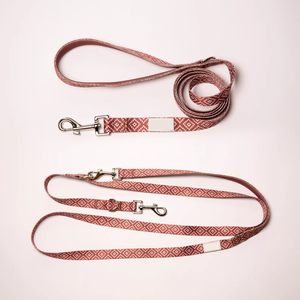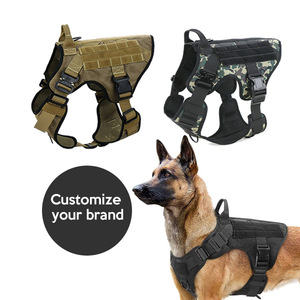(14689 products available)
























































































































































































Large dog harnesses are specially designed dog gear for training, walking, running, and other outdoor activities. They are meant to befit bigger, heavier dog breeds. Unlike dog collars, which can be detrimental to the dog's neck, especially when the dog pulls hard, the harness distributes the pulling force across the dog's body. It thus gives the owner better control over the dog. Below are the types of large dog harnesses on the market:
Standard Harness
Standard harnesses for large dogs are designed with three parts: the neck, chest, and belly areas. They have a simple design that comprises a strap-like structure that goes around the neck and the chest of the dog. The strap connected to the neck part goes across the chest and connects at the back of the dog. The standard harness is easy to wear and remove. It is suitable for daily walks and exercise sessions. It is also good for both seasoned and novice dog owners.
Front Clip Harness
As the name suggests, the front clip harness has a leash attachment at the front of the harness, right on the dog's chest. This attachment gives the owner more control over the dog and helps to redirect the dog's energy towards the owner instead of the side. This is a good option for large dogs who are still in training. It helps to prevent the dog from tangling up in the leash since it helps to control the dog's movement. It is also good for daily walks.
Back Clip Harness
The back clip harness has the leash attachment at the back of the harness, right in between the dog's shoulder. This type of harness is suitable for well-trained dogs who do not pull on the leash. It is simple to use and comfortable for the dog. It is also a good option for daily walks and outdoor activities.
Multi-Use Harness
These are large dog harnesses that are designed for multiple uses. They can be used as a training harness, walking harness, and seat belt harness, among others. They are adjustable and are great for growing puppies.
Step-In Harness
This type of harness is easy to put on, as the name suggests. It has two front leg straps and a rear connector that goes under the belly and clicks or straps in at the back. With a step-in harness, the dog simply steps into the leg straps. It is a good option for both seasoned and novice dog owners. It is comfortable and ideal for daily walks.
Padded Harness
The padded harness has soft paddings on the straps and inner part of the harness. It is designed to prevent chafing and discomfort for the dog. It is a good option for long walks and for dogs who are still getting accustomed to wearing a harness.
Large dog harnesses come in many designs to suit different breeds and activities.
Form
The most common design is the back-clip harness. The clip for the leash is on the back between the shoulder blades. This design is suitable for well-trained dogs who do not pull on the leash. It is also great for casual walks and light activities.
Front-clip harness
The front-clip harness has the clip for the leash on the chest. This design is suitable for training dogs to stop pulling on the leash. It gives better control and helps to steer the dog. It helps to control pulling by turning the dog around instead of pulling their neck.
Dual-clip harness
This type of harness has both front and back clips. It is versatile and allows for different attachment points. The user can use it to train or walk the dog in a way that is comfortable for both of them.
Vest-style harness
This design looks like a vest and covers the dog's chest and belly. It distributes the pressure of the leash evenly and makes it comfortable for the dog. It is suitable for large dogs. It is also good for daily walks and dogs that pull on the leash a lot.
H-back harness
This design has two loops on the back of the dog and one loop on the chest. It is suitable for dogs with a slim build and short necks. It is good for training and daily walks. It is also great for active dogs because it allows free movement.
Adjustable harness
Some harnesses have adjustable straps. They can fit dogs of different sizes and shapes. The user can adjust the fit as the dog grows. It is great for puppies or dogs with weight changes.
Specialized harness
Some specialized harnesses have designs for specific purposes. Some examples are the no-pull harness, tactical harness, and service dog harness. Each specialized design has features that make it suitable for its purpose.
Daily Walking and Exercise:
Large dog harnesses are perfect for daily walks and exercise routines. They offer great control and comfort, making the experience enjoyable for both the pet and the owner.
Training Sessions:
Training is another important use of dog harnesses. During obedience training or behavior correction, a harness gives the owner precise control over the dog, which is important for effectively teaching commands or correcting misbehavior.
Vet Visits and Grooming:
For trips to the veterinarian or visits to a grooming salon, a harness can help keep the dog calm and secure in unfamiliar environments. It prevents sudden pulls or escapes that could cause panic in such situations.
Traveling:
When traveling with dogs, especially by car, a large dog harness becomes an essential safety device. It prevents distractions while driving and ensures the safety of both passengers and pets.
Hiking and Outdoor Activities:
For owners who love hiking or outdoor activities, a harness is useful for these scenarios too. It allows for better leash control on rough terrain, provides comfort during long walks, and reduces strain on the dog's neck in case of sudden pulls.
Cold Weather:
In colder months or regions with chilly weather, harnesses can also be used to put on dogs' warm coats. Some models have a back panel designed specifically for this purpose, making it easier to dress the dog for winter walks.
Assisting Special Needs Dogs:
Dogs with disabilities or senior dogs may need help moving around. Assistive harnesses with handholds or slings can support such dogs, helping them walk independently while maintaining dignity.
Opting for the right dog harness is critical for ensuring comfort and safety of the pet. As such, people should take into account a variety of factors when choosing a large dog harness.
Size and breed of the dog
Clearly, the size and breed of the dog should be considered. Different breeds have distinct body shapes and sizes. For instance, a greyhound will require a different harness than a bulldog. Moreover, large breeds like Great Danes or Mastiffs need harnesses that can accommodate their size yet prevent them from slipping out. Hence, it is important to measure the dog's girth, neck and weight before selecting a suitable harness.
Purpose of the harness
There are various types of harnesses available, each serving different purposes. If the dog is used for pulling activities such as sledding or carting, then one should look for an appropriate pulling harness designed specifically for that purpose. On the other hand, if people are seeking an everyday walking tool, opt for a basic training or walking harness. Additionally, behavior control harnesses like no-pull or escape proof options can be beneficial for dogs who tend to tug on their leash or are prone to getting away from their gear respectively.
Material and durability
Consider the material used in constructing the harness as well as its overall durability. Opt for sturdy materials such as nylon or polyester that are able to resist wear-and-tear, especially for higher energy dogs. Furthermore, large dog harnesses should be well built since bigger dogs have more strength. Additionally, take into account weather-resistant features if the dog will be exposed to various environmental conditions.
Comfort and fit
Comfort and fit are crucial for any dog gear. A proper fit of the harness should distribute pressure evenly across the dog's body, thus preventing strain or injury. Look out for adjustable straps that can be customized according to the dog's size while also ensuring secure hold. Moreover, padded and wide straps offer comfort during long walks or training sessions. Also, make sure that the harness does not rub against the dog's skin or cause chafing.
Ease of use
Lastly, consider the ease of use of the harness. Opt for designs that have quick-snap buckles and are simple to put on or take off. Additionally, look for features such as leash attachment points, both at the back and front, which allow for versatile handling options during walks.
Q1: What are the benefits of using a dog harness instead of a dog collar?
A1: A dog harness provides more control over a dog and distributes the pulling force evenly across the dog's body, which minimizes the risk of injury. It's especially beneficial for large dog breeds, as it reduces strain on their necks and prevents choking. Harnesses are excellent for training, walking, and managing active or behaviorally challenged dogs.
Q2: Which large dog harness is the best for gentle walking?
A2: The best for gentle walking is a no-pull dog harness. These harnesses have special designs that discourage pulling behavior. They make walking easier and more enjoyable for both the dog and the owner. No-pull harnesses usually have a front leash attachment that helps steer the dog without pulling on their neck.
Q3: What features should be considered when choosing a large dog harness?
A3: When choosing a harness, consider its size, fit, comfort, and material. It should be the right size and fit comfortably without chafing or restricting movement. Look for durable materials and designs with padding, adjustable straps, and easy-to-use buckles.
Q4: How can one tell if the harness fits well?
A4: A well-fitting harness should have neither too tight nor too loose. It should allow freedom of movement but be snug enough that the dog cannot escape. Check by seeing if you can fit two fingers under the harness straps on your dog.
Q5: Are any special harnesses for specific dog breeds or sizes?
A5: Yes, some harnesses are designed for specific breeds or sizes. Large breeds benefit from harnesses made specifically for them. They are often more robust and have larger fittings.